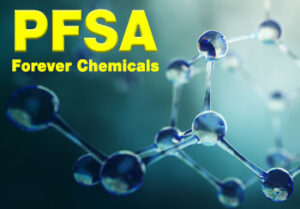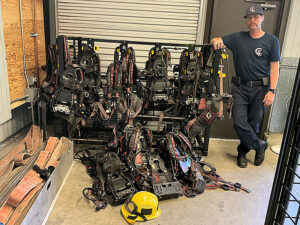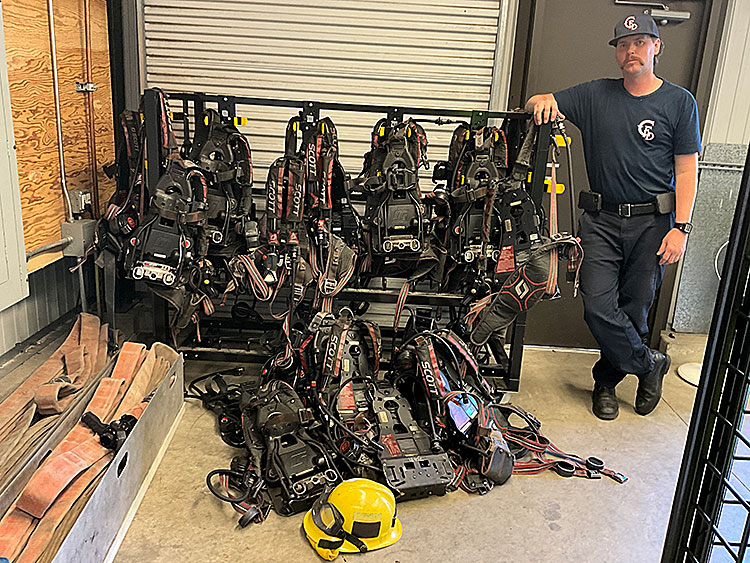 This is the committee that votes on standards for firefighter safety gear.
This is the committee that votes on standards for firefighter safety gear.
- James Allen, Intertek Testing
- George Berger, US Marine Corps
- Steve Corrado, Underwriters Lab
- Paul Curtis, L. N. Curtis & Sons
- Anthony Denton, North Carolina State University
- David Fanning, E.D. Bullard Co.
- Jonathan Fesik, Fire Industry Repair Maintenance Inc
- William Fithian, ASTM/Safety Equipment Institute
- Patricia Freeman, Globe Manufacturing Co., LLC
- A Ira Harkness, U.S. Dept of the Navy
- William Haskell III, National Institute for Occupational Safety & Health
- John Karban, FireDex LLC
- Steve Lakey, Northwest Safety Clean Inc.
- Karen Lehtonen, Lion Group, Inc.
- Michael McKenna, Michael McKenna & Associates, LLC
- Louis Ott, Gentex Corp.
- Tom Ragan, Shelby Specialty Gloves
- John Rihn, Mine Safety Appliances Co.
- R Wendell Fillmore, National Volunteer Fire Council
- Jeffrey Stull, International Personnel Protection Inc.
- Robert Tutterow Jr, Fire Industry Equipment Research Organization
- Harry Winer, HIP Consulting LLC
Firefighter Representatives
- Tim Derby, Prescott Fire Dept
- Richard Granger Jr, Charlotte Fire Dept
- Earl Hayden, International Association of Fire Fighters
- Kim Klaren, Fairfield County Fire & Rescue
- Jim Reidy, San Antonio Fire Dept
- John Rhodes Jr, Kingman Fire Dept
- Kelly Simon, Heartland Fire & Rescue
- Tim Tomlinson, Addison Fire Dept
- Richard Weise, Los Angeles County Fire Dept
•••
Travis Temarantz of Wilkes-Barre City Firefighter’s Union IAFF Local 104 president and Cancer Committee chair proposed:
 “Currently, turnout gear is being manufactured with the use of certain chemicals that are known Per- and Polyfluoroalkyl Substances, commonly known as PFAS. These chemicals are widely known to cause an increased risk of certain health conditions including cancer. For years, end-users of turnout gear have been wearing these garments with no knowledge of being exposed to PFAS chemicals. While, manufacturers explain what some garments are made out of, there has been no specific disclosure of these materials being made with PFAS. The end-user should have the right to understand what they are wearing on a daily basis. This would be the first step to acknowledge that garments contain chemicals known to cause increased health risks.”
“Currently, turnout gear is being manufactured with the use of certain chemicals that are known Per- and Polyfluoroalkyl Substances, commonly known as PFAS. These chemicals are widely known to cause an increased risk of certain health conditions including cancer. For years, end-users of turnout gear have been wearing these garments with no knowledge of being exposed to PFAS chemicals. While, manufacturers explain what some garments are made out of, there has been no specific disclosure of these materials being made with PFAS. The end-user should have the right to understand what they are wearing on a daily basis. This would be the first step to acknowledge that garments contain chemicals known to cause increased health risks.”
NFPA Standard 1971 now 1970
The National Fire Protection Association says Standard 1971 protects fire-fighting personnel by establishing minimum levels of protection from thermal, physical, environmental, and bloodborne pathogen hazards encountered during structural and proximity fire-fighting operations.
As part of the Emergency Response and Responder Safety Document consolidation, approved by the NFPA Standards Council, this standard is being combined into a new consolidated draft, NFPA 1970, Standard on Protective Ensembles for Structural and Proximity Firefighting, Work Apparel and Open-Circuit Self-Contained Breathing Apparatus for Emergency Services, and Personal Alert Safety Systems.



